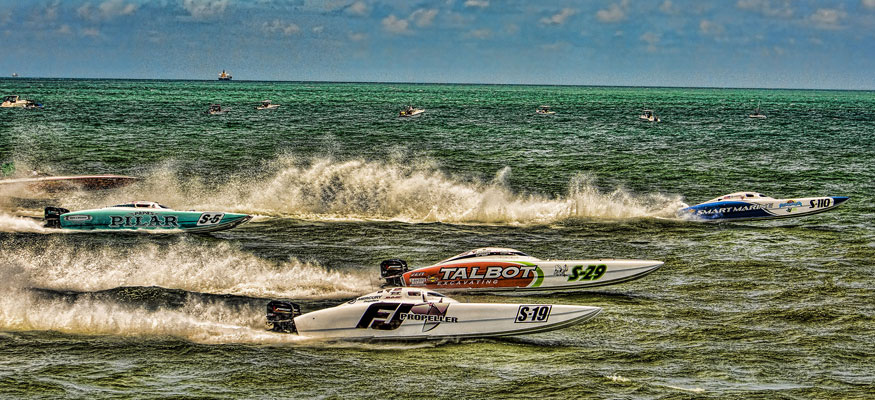Commentary: 10 Reasons the 200XS Is the Right Call for Stock Class
As a longtime Stock-class outboard catamaran racer, I read the speedonthewater.com story, “Mercury Racing Head Sees 400-HP Four-Stroke as Top Choice for Stock Class” closely and with more than a little dismay. As most offshore racers and fans know, I have been working with Mercury Marine 200XS outboards on my 32-foot canopied Doug Wright catamaran as the replacement engines for the long-discontinued, but still spec for the Super Boat International Stock class, 2.5. I’d just like to weigh in with the following 10 points of fact.
1. Stock class is not XCAT. They cannot be compared.
2. Stock class in the United States is not run under the sanction of the Union Internationale Motonautique, the governing body that sanctions XCAT overseas.
3. We know that if we put engines 500 pounds heavier on the back of our boats that we will have to add a lot of weight in the nose to balance the weight. While that works ‘globally,’ adding that much weight to boats designed for current motor weight is not the answer. We shouldn’t be building new boats to accommodate new motors. We should build new motors to work on boats that are being built currently.
4. Regarding the quote, “The 200 XS is not competitive”—If we are all running them, how can they not be? We are not comparing a 200 with a 300 or a 400, we’re only looking for the smartest, most economical, fair replacement through testing and not making assumptions. What works now is far better than saying, “Lets do something we haven’t tried with the 300XS and hope for the best.”
5. One of my competitors and I have tested the 200XS and it runs identical speeds as a 280-hp (2.5L outboard) at 7,600 rpm. I’m not sure why it isn’t a perfect option, especially since the 280-hp outboards can continue to be raced by those who have them and prefer them.
6. The 300XS is a great outboard engine—I have two on the back of my 32-foot pleasure cat pleasure boat. But if using them in Stock class means we have to put on an aftermarket cowling, pan and midsection, adaptor plate and not use the clamp bracket and trim cylinder, and then machine the vertical shaft to 15 inches and re-spline to the power head it doesn’t appear to be close to the “plug and play” equal of the 200XS. If you have to morph together a whole bunch of parts to make your engine work, it’s kind of hard to call it “Stock.”
7. We tested the 200XS at 7,600 rpm on our boat and it runs 105 mph all day. Stock class catamarans seldom reach this speed for more than a tenth of the straightaway during a race. What’s more impressive is that Mercury put a 200XS outboard on a Champ boat, ran it at 8,100 rpm in a 24-hour enduro event, then took it to a 12-hour enduro and then raced it for an a season. Even my limited math tells me we will all save money and effort by running five miles per hour mph slower with proven motors rather than running a few miles per hour faster with 300XS outboards that require a shopping list of parts.
8. All spare parts the Stock-class teams have, i.e. cowlings, pans, clamp brackets, mid-sections, steering, lower units and trim pumps—not to mention all props the teams have—won’t be useable with with any motor other than the 2.5 or 200XS.
9. Yes, the 400-hp four-stroke Verado is super cool and will be the best motor ever for a lot of applications. The 33- to 34-foot X-Cats that are built for the motor will be fantastic. I sat in the meeting in Dubai as the elected XCAT class representative. The 14 teams there were told that the Victory team would cut its boats in half and make them three feet longer—at a cost of $100,000 per boat—to accommodate the new 400-hp four-strokes that would be sold to the teams for around $75,000. I also witnessed the four-stroke run 125 mph effortlessly on a stretched Victory boat and turn consistent lap times that were 10 seconds faster than those of 280-hp outboard-powered boats. Mercury Racing has done a great thing to research and design this prototype outboard so when it does arrive it will be ready for racing. But again, that’s XCAT, not Stock class.
10. Having raced outboard-powered catamarans offshore for 30 years—seven of those in the Middle East—in an effort to help find a solution for our Stock class in the U.S. I put a pair of 200XS engines on my boat. I did that to demonstrate what they will do, not what they won’t.
Related stories
Stock-Class Future Leaning Toward 300XS Outboards But Not Finalized
Mercury Racing Head Sees 400-HP Four-Stroke as Top Choice for Stock Class
Photo courtesy/copyright Jay Nichols/Naples Image


